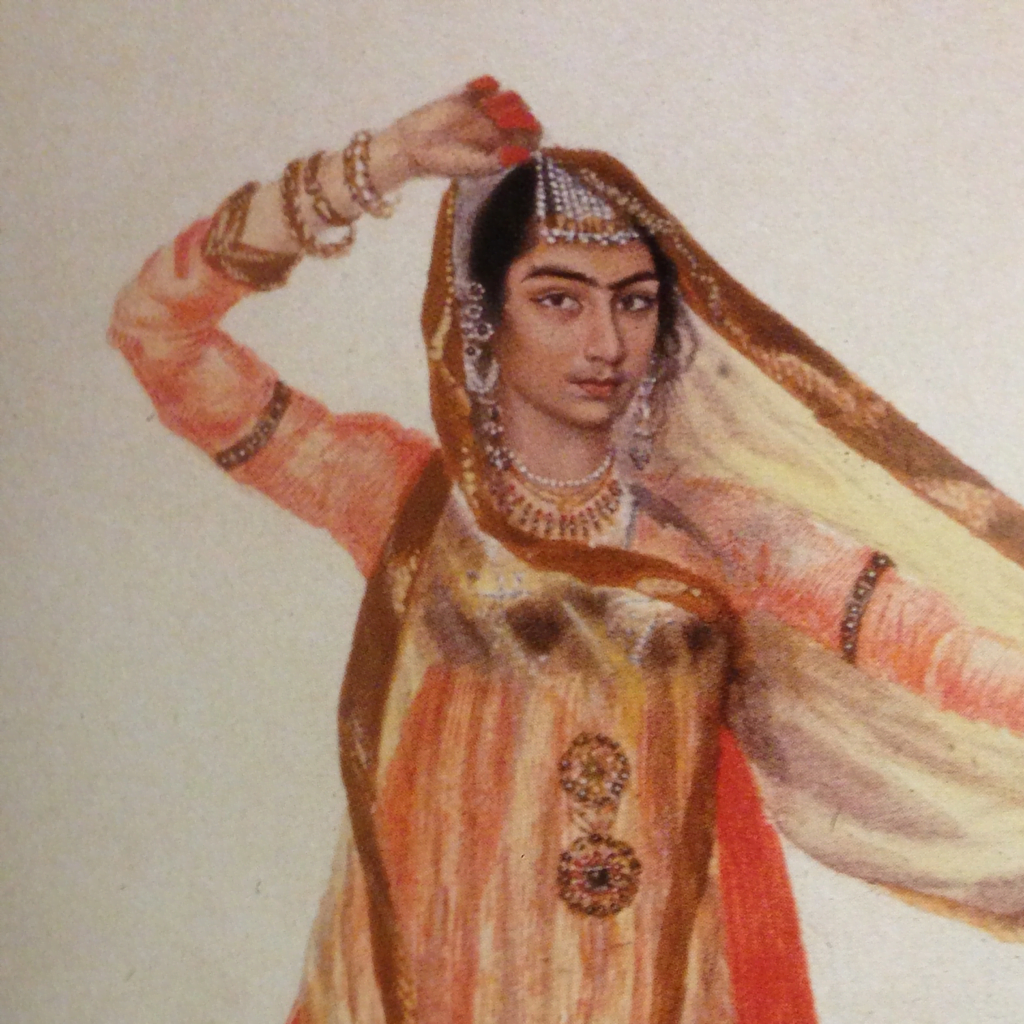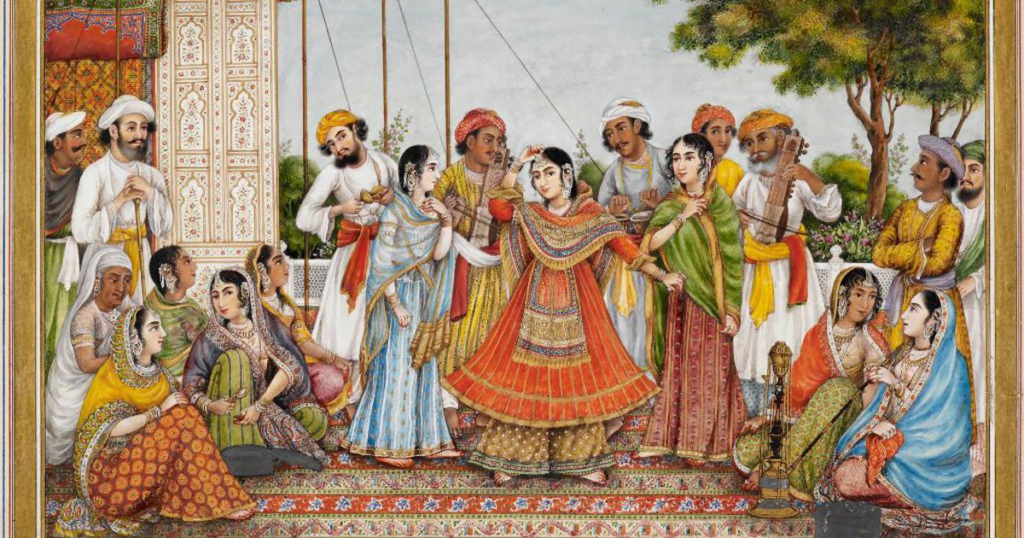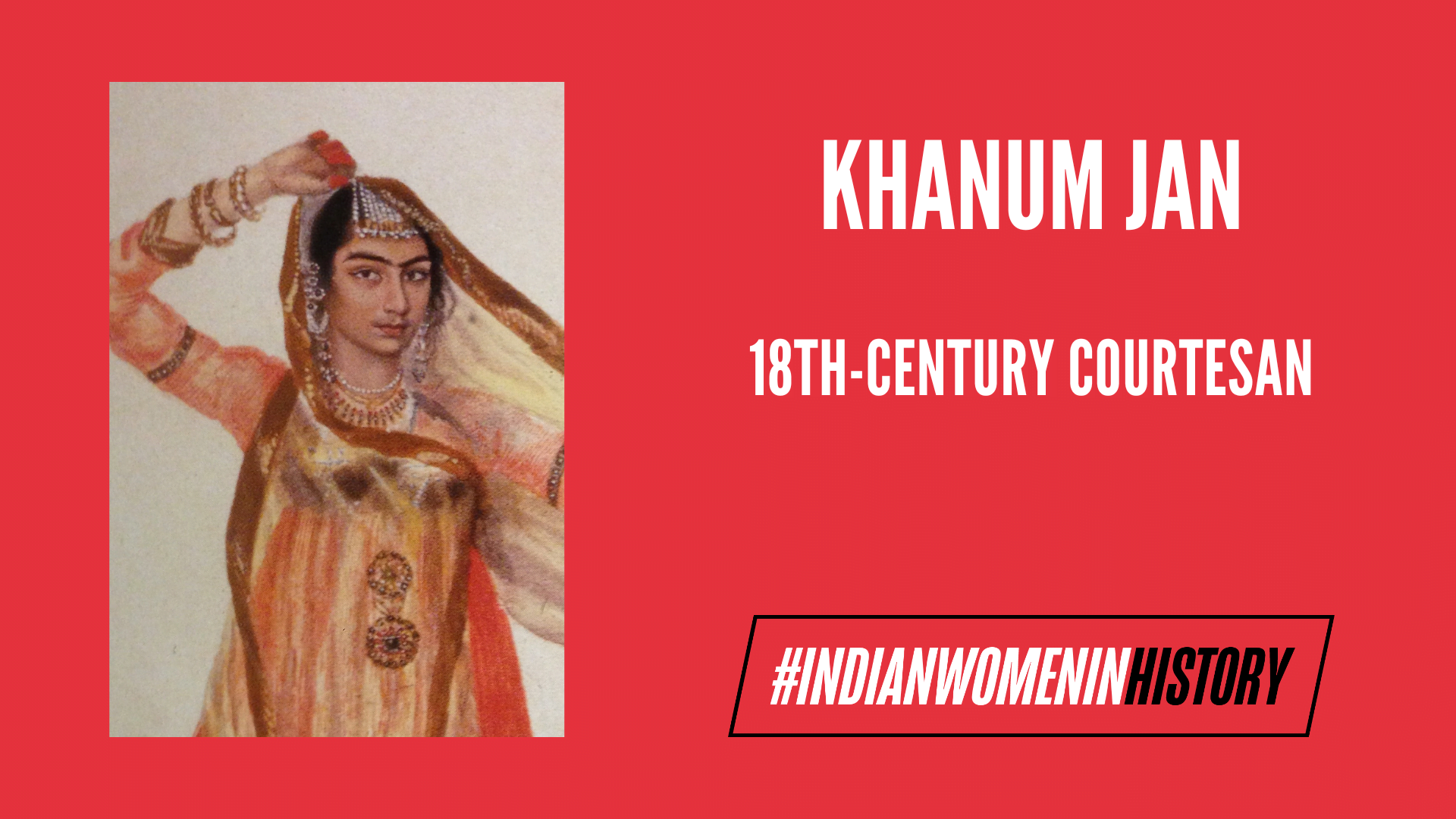A troupe of singers of Sufi songs from Kashmir, among other such bands, performed for the elite of Lucknow in the late 18th century. This particular Nautch set (a distortion of the word Nach, meaning dance) was led by the celebrity courtesan Khanum Jan. The details of her life are unknown. Her birth and death date, her age, and a record of crucial events in her life can only be speculated.
What we know for certain is that she was highly trained in Hindustani music, poetry, courtly etiquette and wit, and, as the scholar Katherine Butler Schofield playfully puts it, the art of seduction. Performing for the Awadhi elite as well as Europeans, Khanum Jan was cognisant of the distinct tastes of the Mughal elite who felt the nuances of the Ragas and the Europeans who took pleasure in the repetition of rhythms and metres. She artfully balanced the two in her music and appealed to both audiences. As a result, she was famed among the elite circles of Awadhi and British alike.
The dancing girl
Coincidentally, we know a similar Khanum Jan from Sayyid Muhammad Hasan Shah’s autobiography (deemed fictionalised), Afsana-e-Rangin, which was written in 1790. This was rendered in Urdu in 1893. The title was changed to Nashtar—a Surgeon’s knife, which implied “the excruciating pain of love and separation from one’s beloved.” The novel was translated into English—The Dancing Girl—by Qurratulain Hyder in 2003. Owing to the uncanny similarity between Shah’s account of Khanum Jan and those derived from European sources, most prominently Sophia Elizabeth Plowden, it’s likely they were the same person.
Hasan Shah was a munshi (a scholar or a clerk) at “Ming Saheb’s,” cantonment in Kanpur. Ming Saheb’s original name is conjectured to be Charles Manningham. Shah’s tragic tale relates the love story between the munshi and Khanum Jan who married secretly but were separated when Ming Saheb decided to relocate elsewhere.

Khanum Jan and Hasan Shah made plans to go away together, however, he was delayed by Ming Saheb’s demands and Khanum Jan left with her Nautch set. Hasan Shah intended to catch up with her but Khanum Jan got sick on the way, was taken to Lucknow, and died.
One passage in the book describes how Shah felt when he perceived Khanum Jan for the first time:
“She has a magnolia face and narcissus eyes. She must have ruined the piety of a thousand men. Dressed in finery, she ambled in, and struck a pose which was utterly devastating. Our eyes met and I was struck by the arrow of love. I became still like a picture and was petrified like a statue. Then I felt a surge of blood in my veins and my heart fluttered helplessly.“
Further in the novel, Hasan Shah’s account of Khanum Jan tells us that she was an extremely knowledgeable, sensitive, and strong-willed individual engaging in a war of words with the munshi through the ghazals of Hafiz. However, his patriarchal male fantasies dictated his attraction toward her. He looked down upon tawaifs and considered them lowly:
“To be precise, here are the points why I adore you: God has bestowed on you the following qualities:
Sense of honour and self-respect. Also modesty to a proper degree.
Chastity.
Politeness. Sweet Speech. Brilliance.
Steadfastness.
The ability to understand human nature, good judgement, and loyalty are qualities I have not yet tested in you, but a person with all these characteristics must be extraordinary. It is a pity that you are trapped amongst people who have nothing to do with these qualities.”
Khanum Jan, and the Hindustani airs
Sophia Plowden’s interaction with Khanum Jan, uncovered by Katherine Schofield in the British Library, gives a fuller picture of Khanum Jan’s artistic talents. Sophia Plowden, along with her husband—an East India Company officer—was a resident of Calcutta and Lucknow from 1777 to 1790. Lucknow at the time was under the rule of Nawab Asaf-ud-Daula.
Plowden, amongst other Englishwomen, was deeply interested in Nautch performances and enthusiastically documented Khanum Jan’s performances in her tune book. Usually, these tunes were adapted for European tastes and harmonised in keyboard notations with English lyrics that bore no resemblance with the original Hindustani or Persian lyrics. These came to be known as Hindustani airs. Schofield’s essay, “Words without songs,”: the social history of Hindustani song collections in India’s Muslim courts c.1770–1830 defines Hindustani air as “anything that Europeans could readily distinguish as a fixed song composition, largely because it emphasised text over rāg.”

They gained immense popularity in British colonial society in North India and Bengal in the 1780s and ‘90s. However, Plowden was not unique in documenting these tunes (for instance, William Bird and Colonel Polier). What set her apart from other collectors was that along with the melodies, she also collected the lyrics of the songs, transcribing them from languages of North Indian courtly songs. Moreover, she performed the songs herself in front of European circles and Schofield suggests that Plowden may have regarded Khanum Jan the way an Englishwoman would regard a celebrity opera singer in London.
Plowden often performed these songs in soirees and donned Indian attire characteristic of a sophisticated courtesan to lend greater ‘authenticity,’ to her performances. She performed even in front of Asaf-ud-Daula and was awarded the title of Begum by Shah Alam II Emperor Shah Alam II for her “exceptional devotedness, and rare fidelity, high titles and honourable address.” Plowden was instrumental in the promotion of Hindustani airs.

Ghazals, extensively performed by Khanum Jan, were more appropriate for European-style notations “because they had clear lyrics, regular meters, and repeated tunes.” Ghazal is a form of Persian and Urdu poetry based on rhyming metrical couplets which were set to Indian melodic codes called Ragas. Ghazals were also more comprehensible to European ears.
We don’t know Khanum Jan through her own voice, as is the case with most courtesans and Englishwomen at the time. They have mostly been written by men, making it extremely difficult to get to the individual as she was.
References:
- The podcast by Katherine Butler Schofield: https://soundcloud.com/user-513302522/the-courtesan-and-the-memsahib-khanum-jan-meets-sophia-plowden-at-the-18c-court-of-lucknow
- A blog post by Katherine Butler Schofield: https://blogs.bl.uk/asian-and-african/2018/06/sophia-plowden-khanum-jan-and-hindustani-airs.html
- The Courtesan Tale: Female Musicians and Dancers in Mughal Historical Chronicles, c.1556–1748: https://www.academia.edu/42271218/The_Courtesan_Tale_Female_Musicians_and_Dancers_in_Mughal_Historical_Chronicles_c_1556_1748
- From Tawaif to Nautch Girl: the Transition of the Lucknow Courtesan: https://www.tandfonline.com/doi/abs/10.1080/02759527.2014.11932977
- The Dancing Girl by Hasan Shah, translated by Qurratulain Hyder: https://archive.org/details/dancinggirlnovel0000hasa/page/42/mode/2up?view=theater
- Theory and Practice in the Music of the Islamic World: Essays in Honour of Owen Wright: https://www.amazon.in/Theory-Practice-Music-Islamic-World/dp/1138218316
- Nautch Girls of India by Pran Nevile: https://www.amazon.in/Nautch-Girls-India-Dancers-Playmates/dp/8190068806
- The ‘Hindostannie Air’: English Attempts to Understand Indian Music in the Late Eighteenth Century by Ian Woodfield: https://www.jstor.org/stable/766519
About the author(s)
Shakti (she/her) is an English major and an aspiring tea sommelier. She loves reading poetry and drama and can be found with a Kindle most time. She intends to become a teacher of humanities and is passionate about literature, films, politics, and history. In her free time, she has been caught watching cringe content, however, she fervently denies these claims.





